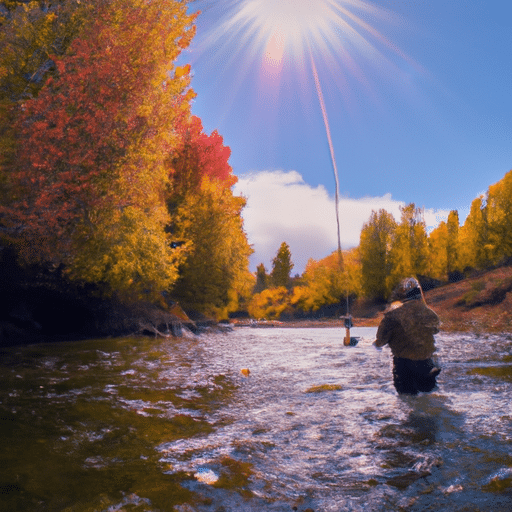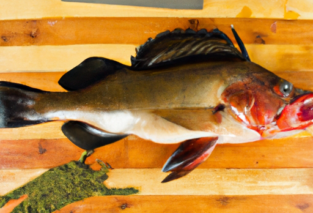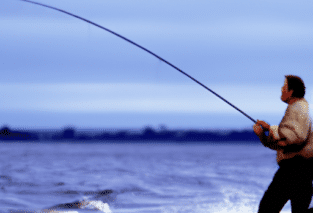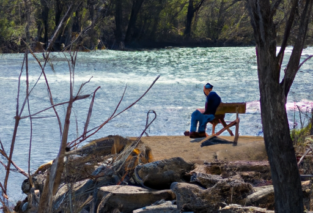If you’re an avid angler who loves trout fishing, you might be wondering whether fall is a good time to pursue your favorite hobby. Look no further! The comprehensive guide, “Can You Go Trout Fishing in Fall: Essential Tips and Techniques,” has arrived to answer all your questions and equip you with the necessary knowledge and skills for successful autumn fishing. Join us as we explore the best methods, tricks, and strategies to make the most out of your trout fishing adventures during this picturesque season.

Best Time to Go Trout Fishing in Fall
Understanding the Trout Behavior in Fall
In order to have a successful trout fishing trip in the fall, it is crucial to understand the behavior of trout during this season. Fall is a transitional period for trout, as they prepare for the winter months. During this time, trout tend to become more active and aggressive in their feeding habits in order to store energy for the colder months ahead. They also tend to congregate in areas with abundant food sources and suitable conditions. By understanding these patterns, you can increase your chances of having a productive fishing experience.
Identifying Ideal Fishing Conditions
When planning a trout fishing trip in the fall, it is important to identify the ideal fishing conditions. Trout are most active in cooler water temperatures, typically between 50°F and 60°F (10°C and 15.5°C). Therefore, it is recommended to fish during the early morning or late evening when water temperatures are cooler. Additionally, overcast days can provide better fishing opportunities as trout are more likely to venture out of their hiding spots to feed. Pay attention to the weather forecast and choose days when the conditions align with optimal fishing conditions.
Choosing the Right Time of Day
The time of day can greatly impact your success when trout fishing in the fall. As mentioned earlier, the early morning and late evening are prime times to target trout. During these times, trout are more active and actively feeding, as they are less likely to encounter predators and the water temperatures are cooler. It is also important to note that trout are more likely to be found near the surface during these times, making it easier to target them. Plan your fishing trip accordingly and maximize your chances of catching trout during their most active periods.
Essential Equipment for Fall Trout Fishing
Selecting the Appropriate Fishing Rod and Reel
Choosing the right fishing rod and reel is essential for a successful trout fishing trip in the fall. Opt for lightweight, medium-action rods that allow for casting accuracy and sensitivity when detecting bites. Pair the rod with a high-quality spinning reel that has a smooth drag system and can handle the weight of the trout you expect to catch. This combination will ensure that you have the necessary control and strength to reel in these strong and agile fish.
Choosing the Right Fishing Line
When it comes to fishing line, it is recommended to use a monofilament or fluorocarbon line for trout fishing in the fall. Monofilament lines offer good visibility and are more forgiving when it comes to casting distance. On the other hand, fluorocarbon lines are less visible underwater and have a higher abrasion resistance, making them suitable for fishing in rocky areas or where trout may be more cautious. Consider the fishing conditions and choose a fishing line that suits your needs and preferences.
Essential Tackle and Bait for Fall Trout Fishing
To entice trout during the fall season, it is important to have the right tackle and bait. Use a variety of spinners, spoons, and artificial flies in different colors to mimic the natural food sources of trout. Experiment with different sizes and retrieve speeds to find what works best on a given day. Additionally, using live bait such as worms or minnows can be effective, especially when targeting larger trout. Ensure that you have a variety of bait options available to adapt to changing fishing conditions and increase your chances of success.
Location Selection for Fall Trout Fishing
Exploring Local Rivers, Streams, and Lakes
When it comes to trout fishing in the fall, exploring local rivers, streams, and lakes is key. Trout tend to inhabit these freshwater bodies during this season, as they provide an abundance of food sources and suitable conditions. Research local fishing spots and choose areas known for their trout populations. Look for areas with ample cover, such as fallen trees or vegetation, as trout seek shelter in these spots. Be prepared to hike and explore different locations to find trout hotspots and make the most of your fall fishing adventures.
Researching Trout Stocking Programs
Another factor to consider when selecting a fishing location in the fall is the presence of trout stocking programs in your area. Many fisheries and wildlife management organizations stock trout in public waters to ensure a healthy trout population and provide opportunities for anglers. Research local stocking programs and find out when and where trout are being stocked. Fishing in these areas can significantly increase your chances of catching trout and contribute to the overall success of your fishing trip.
Considering the Impact of Changing Water Levels
It is important to consider the impact of changing water levels when selecting a fishing location for fall trout fishing. During the fall, water levels can fluctuate due to rain or other environmental factors. Trout are sensitive to changes in water levels, and their behavior can be influenced by these fluctuations. Depending on the particular body of water you plan to fish, it is essential to keep an eye on water level changes and adjust your fishing strategies accordingly. High water levels can push trout into sheltered areas, while low water levels may make them more wary and selective about biting.

Techniques for Fall Trout Fishing
Casting Techniques for Trout Fishing in Fall
Mastering the art of casting is crucial when trout fishing in the fall. A good cast can make all the difference in reaching the prime fishing spots and presenting your bait or lure effectively. Practice your casting technique, paying attention to accuracy and distance. Aim for precise casts that land softly on the water to avoid spooking the trout. Additionally, learn different casting techniques such as roll casting, sidearm casting, and overhead casting to adapt to various fishing situations and increase your chances of success.
Using Different Rigs and Presentations
Using different rigs and presentations can significantly improve your success when trout fishing in the fall. Experiment with various rig setups such as the Carolina rig, drop shot rig, or bobber rig to find what works best in different fishing conditions. Adjust the depth at which your bait or lure is presented to target trout at different water depths. Additionally, vary your retrieval speed and patterns to mimic the natural movement of prey and trigger a trout’s predatory instincts. Being versatile with your rigs and presentations can make a significant difference in enticing trout to bite.
Employing Various Bait and Lure Techniques
Employing various bait and lure techniques is essential for fall trout fishing. Different baits and lures can appeal to trout depending on their feeding behavior and preferences. Experiment with using live bait such as worms or minnows, as well as artificial baits such as spoons or spinners. Pay attention to the colors, sizes, and patterns of your bait and lures, as trout can be selective based on these factors. Additionally, vary your retrieval techniques by twitching, jerking, or slowly retrieving your bait to simulate the movement of potential prey and trigger a trout’s predatory instincts.
Tips for Catching More Trout in the Fall
Fishing Near Sunken Structures
One effective tip for catching more trout in the fall is to fish near sunken structures. Fallen trees, rocks, and submerged logs create excellent underwater cover for trout. These structures offer shelter and act as hiding spots for prey, making them attractive feeding areas for trout. By targeting these areas, you can increase your chances of encountering trout and enticing them to bite. Use caution when fishing near sunken structures to avoid snagging or losing your tackle.
Fishing in Deep Pools and Undercuts
Fishing in deep pools and undercuts can also lead to success when targeting trout in the fall. Trout often seek refuge in deep pools or undercuts, as they provide protection from predators and allow trout to conserve energy. These areas can be identified by their deeper water and the presence of undercut banks or rocks. Cast your bait or lure near these areas and allow it to sink to the desired depth where trout may be hiding. By targeting these prime areas, you can increase your chances of catching trout during the fall season.
Utilizing Stealth and Slow Techniques
Trout in the fall can be more cautious and easily spooked, so utilizing stealth and slow techniques can greatly increase your chances of success. Approach fishing areas quietly and avoid sudden movements that may startle the trout. Wear neutral-colored clothing that blends in with the surroundings and minimize any unnecessary noise. Additionally, practice a slow and subtle retrieval technique, allowing your bait or lure to imitate the natural movement of prey. By being stealthy and employing slow techniques, you can deceive trout into striking and increase your catch rate.
Understanding Trout Feeding Patterns in Fall
Identifying the Preferred Food Sources
Understanding the preferred food sources of trout in the fall is crucial for successfully targeting them. During this season, trout feed on a variety of aquatic insects, such as mayflies, caddisflies, and terrestrials that fall into the water. Pay attention to the natural surroundings and observe the types of insects present. Select bait or lures that mimic these insects to entice trout into biting. Additionally, consider using imitative patterns such as nymphs, wet flies, or dry flies to match the trout’s preferred food sources and increase your chances of hooking them.
Recognizing the Effect of Water Temperature
Water temperature plays a significant role in trout feeding patterns during the fall season. As the water cools down, trout become more active and aggressive in their feeding habits. They often move to shallower areas of the water where the temperature is more suitable for their metabolism. Keep an eye on water temperature changes and adjust your fishing strategies accordingly. During colder periods, trout may be more active and willing to bite, while during warmer periods, they may be less active and more selective in their feeding.
Adapting to Changing Weather Conditions
Trout feeding patterns are also influenced by changing weather conditions in the fall. Pay attention to weather forecasts and adapt your fishing strategies accordingly. During overcast days or after a light rain, trout tend to be more active and willing to feed. They are more likely to venture out of their hiding spots and show a higher level of aggression towards bait or lures. Adjust your fishing techniques and bait selection based on the weather conditions to increase your chances of enticing trout to bite.
Regulations and Licenses for Fall Trout Fishing
Understanding Fishing Regulations and Limits
Before embarking on your fall trout fishing adventure, it is essential to understand the fishing regulations and limits in your area. Fishing regulations can vary by location and may include restrictions on catch size, bag limits, and specific fishing methods. Familiarize yourself with the regulations governing the body of water you plan to fish and ensure that you comply with the rules. Respecting fishing regulations helps preserve the trout population and ensures sustainable fishing opportunities for future generations.
Obtaining the Necessary Licenses and Permits
To legally fish for trout in the fall, it is important to obtain the necessary licenses and permits. Check with your local fisheries or wildlife management agency to determine the specific licenses and permits required for trout fishing. In many areas, a fishing license is required for anyone who is of legal age and wishes to fish recreationally. Additionally, special permits may be required for fishing in certain locations or for targeting specific species of trout. Ensure that you have all the required licenses and permits before heading out on your fall fishing adventure.
Checking for Seasonal Restrictions and Closures
In some cases, there may be seasonal restrictions or closures in place for fall trout fishing. These restrictions are typically implemented to protect spawning trout or to allow for habitat restoration. Before planning your fishing trip, check for any seasonal restrictions or closures that may be in effect. This information can usually be found on the websites of fisheries or wildlife management agencies. By being aware of these restrictions, you can avoid unintended violations and help in the conservation efforts of trout populations.
Safety Tips for Fall Trout Fishing
Dressing Appropriately for Changing Weather
When engaging in fall trout fishing, it is important to dress appropriately for the changing weather conditions. Layering your clothing is key, as the temperatures can fluctuate throughout the day. Start with a moisture-wicking base layer to keep you dry and comfortable. Add a insulating mid-layer such as a fleece jacket or sweater to keep you warm. Finally, top it off with a waterproof and windproof outer layer to protect you from any inclement weather. Don’t forget to wear a hat, gloves, and appropriate footwear to ensure your overall comfort and safety.
Practicing Proper Casting and Handling Techniques
Practicing proper casting and handling techniques is essential for your safety and the well-being of the trout. When casting, be mindful of your surroundings and avoid casting near other anglers or bystanders. Always keep a safe distance and make sure your casting area is clear. When handling trout, wet your hands to avoid removing the protective slime coating on their bodies. Support the trout gently and avoid squeezing or mishandling them. By practicing proper techniques, you can ensure a safe and enjoyable fishing experience for both you and the trout.
Being Aware of Potential Hazards
Fall trout fishing may involve certain hazards that you need to be aware of and prepared for. Slippery rocks, uneven terrain, and fast-flowing water can pose risks, especially after rain or during high water levels. Use caution when moving around, especially in and around streams and rivers. Wear appropriate footwear with good traction to avoid slipping and falling. It is also advisable to carry a first aid kit in case of any minor injuries or accidents. By being aware of potential hazards and taking the necessary precautions, you can minimize the risks and enjoy your fall trout fishing adventure safely.
Conservation of Trout Habitat in Fall
Understanding the Importance of Habitat Conservation
Conservation of trout habitat is of utmost importance during the fall season. Healthy habitat is essential for the survival and well-being of trout populations. Protecting and preserving their habitat ensures that there are suitable spawning areas, food sources, and shelter for trout to thrive. Avoid disturbing natural habitat features such as fallen trees or vegetation, as these provide crucial cover for trout. Follow Leave No Trace principles and practice responsible fishing to minimize your impact on the environment and contribute to the conservation of trout habitat.
Practicing Catch and Release
Practicing catch and release is a crucial aspect of trout habitat conservation in the fall. Trout are a valuable resource that should be preserved for future generations of anglers. When catching trout, handle them with care and minimize the time they spend out of water. Use appropriate tools such as barbless hooks and hemostats to gently remove the hook. If possible, keep the trout in the water while removing the hook and release them quickly and efficiently. By practicing catch and release, you can ensure the survival and sustainability of trout populations.
Participating in Stream and River Cleanup Programs
Participating in stream and river cleanup programs is another effective way to contribute to the conservation of trout habitat in the fall. Rivers and streams can be heavily impacted by litter and pollution, which can adversely affect trout and their habitats. Look for local community events or organized cleanup efforts in your area and volunteer your time to help clean up rivers and streams. By doing so, you are not only improving the habitat for trout but also benefiting the overall ecosystem and water quality.
Enjoying the Fall Trout Fishing Experience
Taking in the Beautiful Fall Foliage Views
One of the greatest joys of fall trout fishing is taking in the beautiful fall foliage views. As you explore rivers, streams, and lakes in search of trout, take a moment to appreciate the stunning colors of the changing leaves. The vivid reds, oranges, and yellows create a picturesque backdrop for your fishing adventures. Soak in the natural beauty around you and let it enhance your overall fall trout fishing experience.
Spending Quality Time Outdoors
Fall trout fishing provides an opportunity to spend quality time outdoors and immerse yourself in nature. Embrace the solitude and tranquility that fishing provides as you connect with the natural world around you. Enjoy the sounds of the flowing water, the chirping of birds, and the rustling of leaves. Use this time to unwind, relax, and recharge from the stress and demands of everyday life. Fall trout fishing offers an escape into the beauty of nature and a chance to reconnect with the simpler pleasures of the outdoor world.
Connecting with Nature and Finding Relaxation
Fall trout fishing offers a perfect opportunity to connect with nature and find relaxation. As you cast your line and wait for a bite, take a deep breath and let yourself feel the calming effects of being surrounded by nature. Allow the rhythm of the water and the sounds of the wilderness to wash away any worries or stresses. Fishing is not just about catching fish; it is about finding a sense of peace and harmony with your surroundings. Take the time to appreciate the experience and find solace in the beauty of fall trout fishing.





